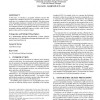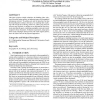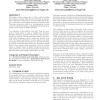GIR
2006
ACM
14 years 6 months ago
2006
ACM
Many documents that can be found in the World Wide Web include some kind of geographical information, often in an implicit way. The use of resources like gazetteers and geographic...
GIR
2006
ACM
14 years 6 months ago
2006
ACM
In this paper, we introduce a geographic similarity operator that computes the relatedness between two geographic places and describe how it is combined with textual ranking. The ...
GIR
2006
ACM
14 years 6 months ago
2006
ACM
Most human activities occur around where the user is physically located. Knowing the geographical serving area of web resources, therefore, is very important for many web applicat...
GIR
2006
ACM
14 years 6 months ago
2006
ACM
In this paper, we present a novel indexing data structure called RDHT (Range capable Distributed Hash Table) derived from skip lists and specifically designed for storing and retr...
GIR
2006
ACM
14 years 6 months ago
2006
ACM
Vague spatial information such as “x is located at walking distance of y” is abundant on the web. In this contribution, we propose a framework to represent such spatial inform...
GIR
2006
ACM
14 years 6 months ago
2006
ACM
GIR
2006
ACM
14 years 6 months ago
2006
ACM
This paper proposes simple techniques for handling place references in search engine queries, an important aspect of geographical information retrieval. We address not only the de...
GIR
2006
ACM
14 years 6 months ago
2006
ACM
A key problem that arises when unstructured text is being queried is that of properly recognizing and exploiting geographical terms and entities. Here we describe a mechanism for ...
GIR
2006
ACM
14 years 6 months ago
2006
ACM
Metonymic location names refer to other, related entities and possess a meaning different from the literal, geographic sense. Metonymic names are to be treated differently to im...
GIR
2006
ACM
14 years 6 months ago
2006
ACM
Retrieving data based not only on key words is a challenge. We worked on semi-structured data (cultural heritage corpora). Our project aimed at getting the most relevant text-unit...





